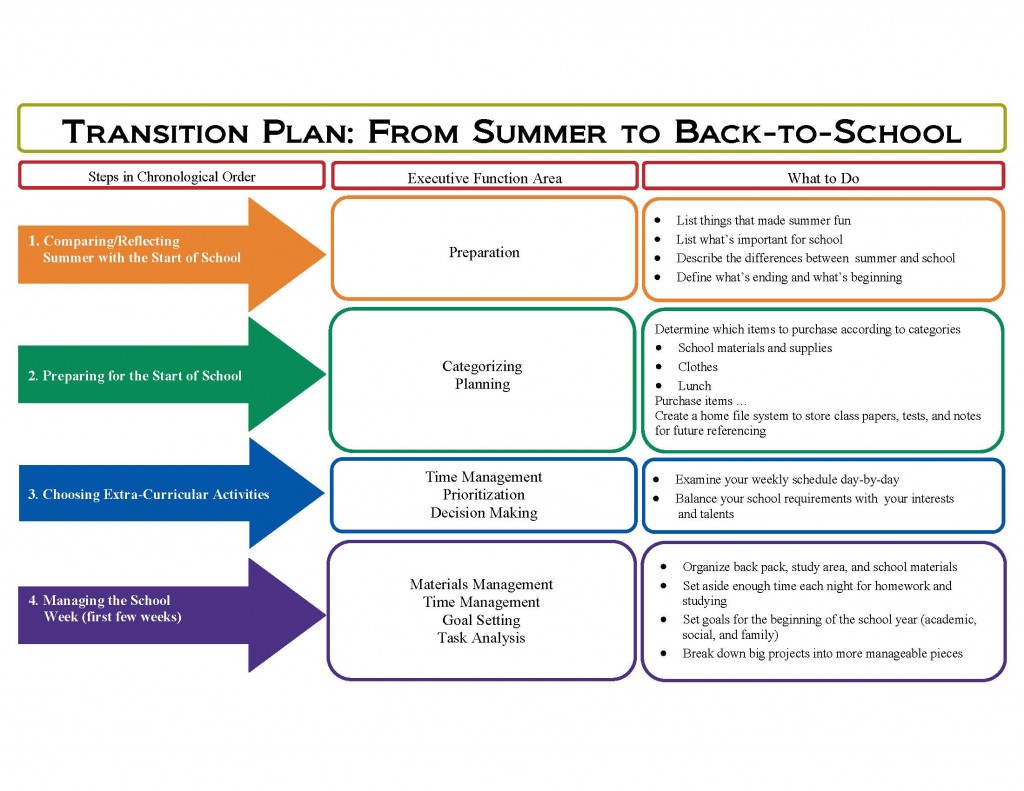Using Executive Functions to Navigate the Back to School Transition
By Georgia Bozeday, Ed.D.
Executive Functions Back-to-School Transition Plan | Printable pdf version
Those of us who teach Executive Functions at RNBC would begin reading this article by highlighting the three key terms in the title. These are: Executive Functions, Transition, and Back to School. In our work with schools and our tutoring sessions at the Center, we help students recognize that their first task is to understand what’s being asked of them. Similarly, the first task for those reading this article is to understand the title.
Let’s start with the word transition. The dictionary definition provides synonyms like passage and change. Although change is listed as a synonym, in this context, change refers to the change process. We need to understand that making transitions involves leaving something behind, i.e., giving up specific aspects of the previous situation in order to move forward. This experience of giving something up may be accompanied by emotional responses that frequently accompany loss, like discomfort and unhappiness. The transition process, therefore, includes paying attention to the emotional concerns that accompany the space between leaving the old and taking on the new.
In describing the other key vocabulary in the title, we know that Executive Functions is a term seated in neuroscience and referencing goal-directed behavior and self-regulation. Executive Function skills impact our ability to successfully plan (short and long-term) as well as to manage the important aspects of daily life. Applying Executive Function skills to help navigate a major transition like adjusting back into the school routine at the beginning of a new academic year, seems like a natural fit.
Examining the emotional response to hearing the phrase, back-to-school is a critical component in our consideration of the title’s meaning. These three words evoke a wide array of responses ranging from excitement and eager anticipation to anxiety and concern. Further, we all must accomplish the back-to-school transition, even those of us struggling with negative reactions. For those looking forward to the resumption of school, applying Executive function skills like organizing materials and setting up a time management system will contribute to extending that positive attitude toward school.
As adults, teachers and parents, we layer our own personal memories and emotional reactions to going back to school with those responses that we imagine our children are experiencing. All parents want their children to start the year in a positive and confident way. Likewise, all students want to have a good year. However, all too often, both parents and students are looking for guidance to start the year off on the right foot.
In many ways, the summer way of living is the antithesis of the demands inherent in academic work. While summer often features more freedom with a relaxed and varied schedule, success in school is based in large part on achieving consistency in most areas of the student’s life, including establishing a consistent and reasonable bed time, maintaining a routine that supports a thorough homework schedule, and creating several different types of structure, including managing materials and assignments so school work can be completed on time and with a minimum of stress.
Each of the above-listed academic skills hinges on the effective utilization of Executive Functions. Teachers, parents and children need to know how to construct and follow plans to organize and manage school expectations and after-school activities, as well as family plans. Applying the higher-level Executive Functions related to problem-solving and decision-making speaks to the heart of the meaning of transition.
Another way to portray this summer-to-school transition is by characterizing summer as a period for unwinding contrasted with fall and school as a period requiring rewinding. While this state is cyclical and naturally occurring, we often experience it as sudden and stress-inducing. Using Executive Functions in endeavors like setting goals, planning, managing time and materials, as well as for higher-order problem-solving, facilitates a smooth transition from summer to the beginning of the school year.
In addition to this article, the Educational Services Department has developed a back-to-school transition plan using Executive Functions as a guide. We employed a strategy called “backward planning” which means we started at the end (in this case the first weeks of school) and generated the plan backwards. Even if school has already begun, teachers, parents, and students can use this guide to help navigate the shift from summer’s freedom to the demands of the school

